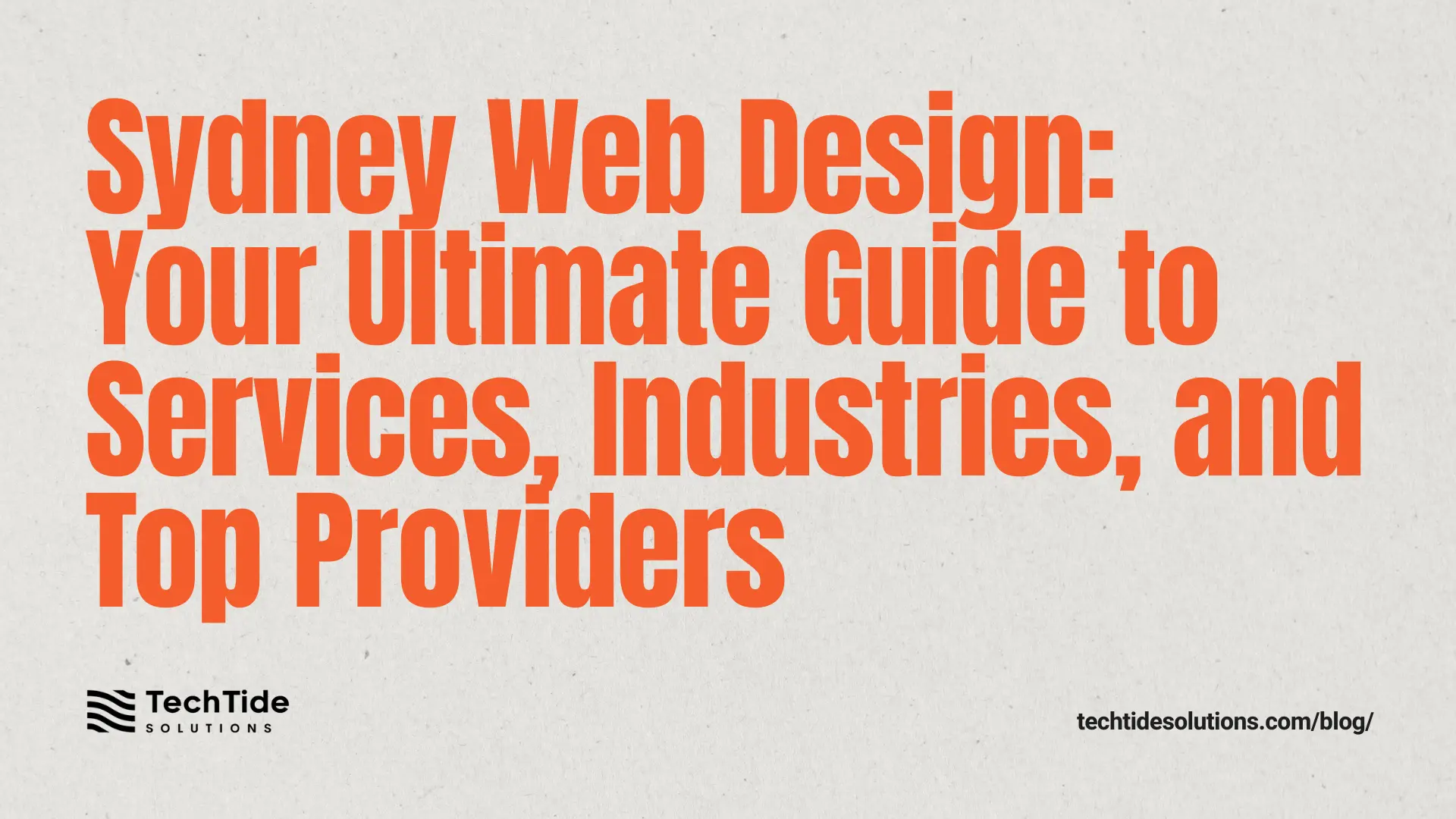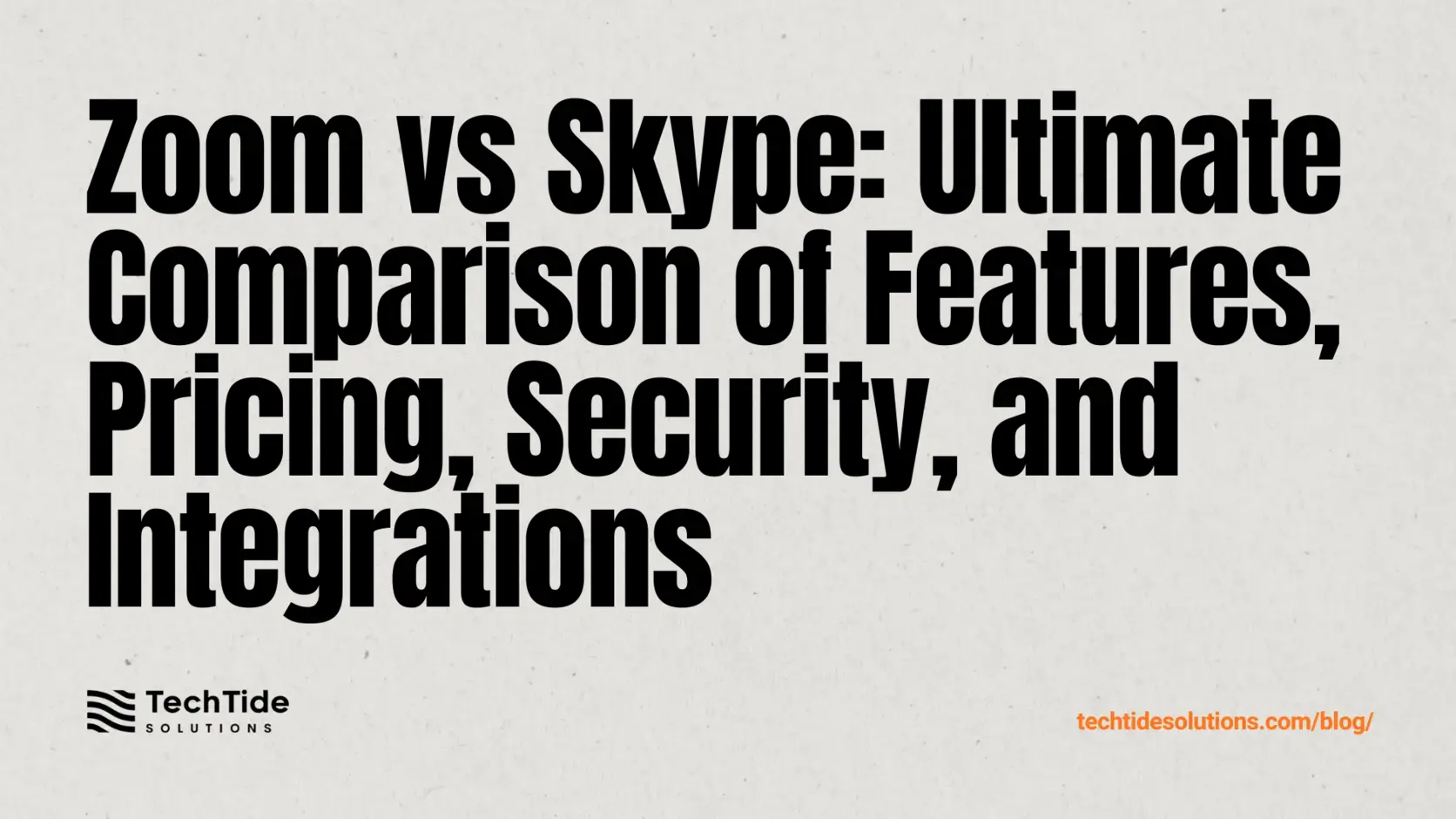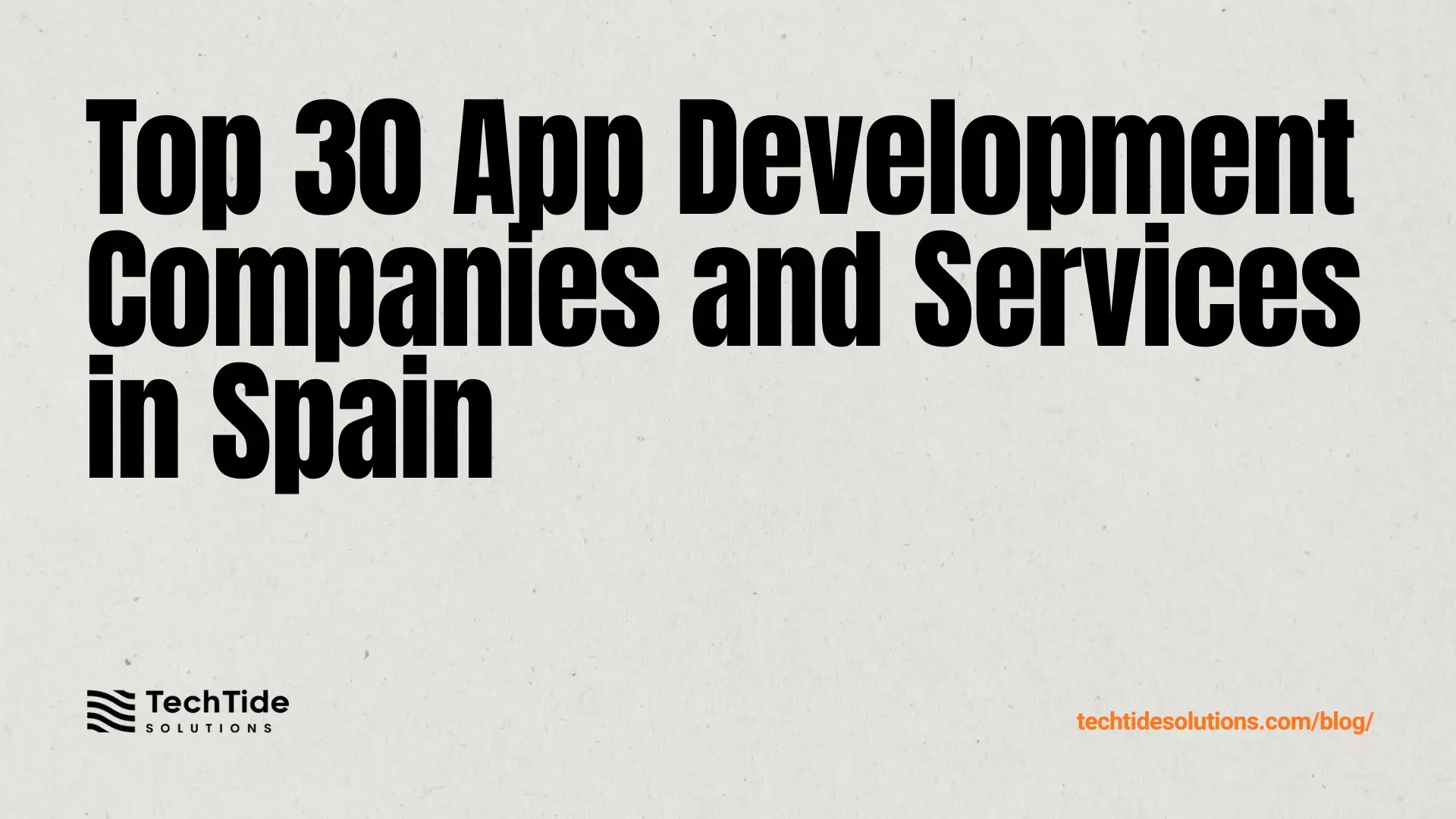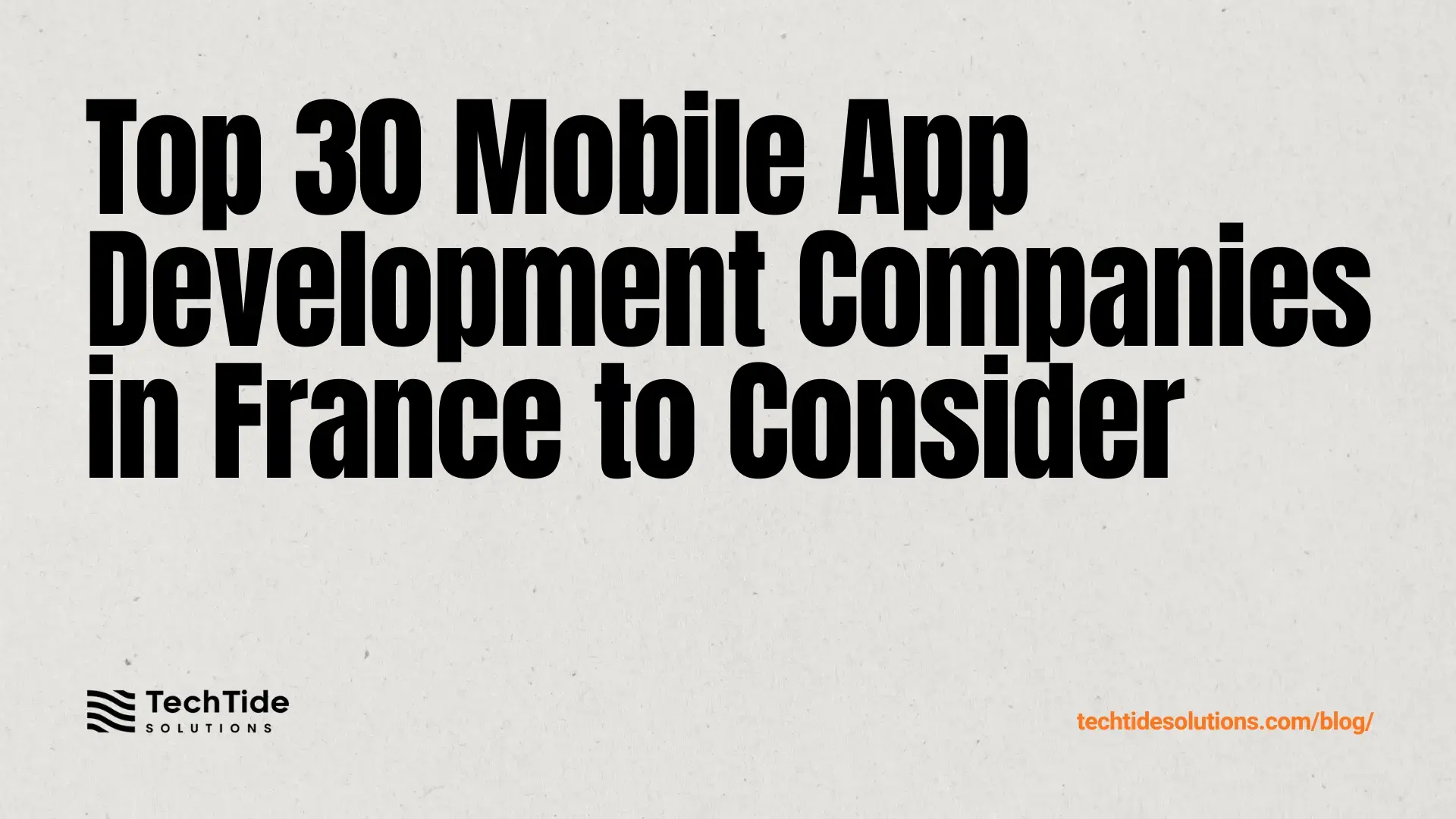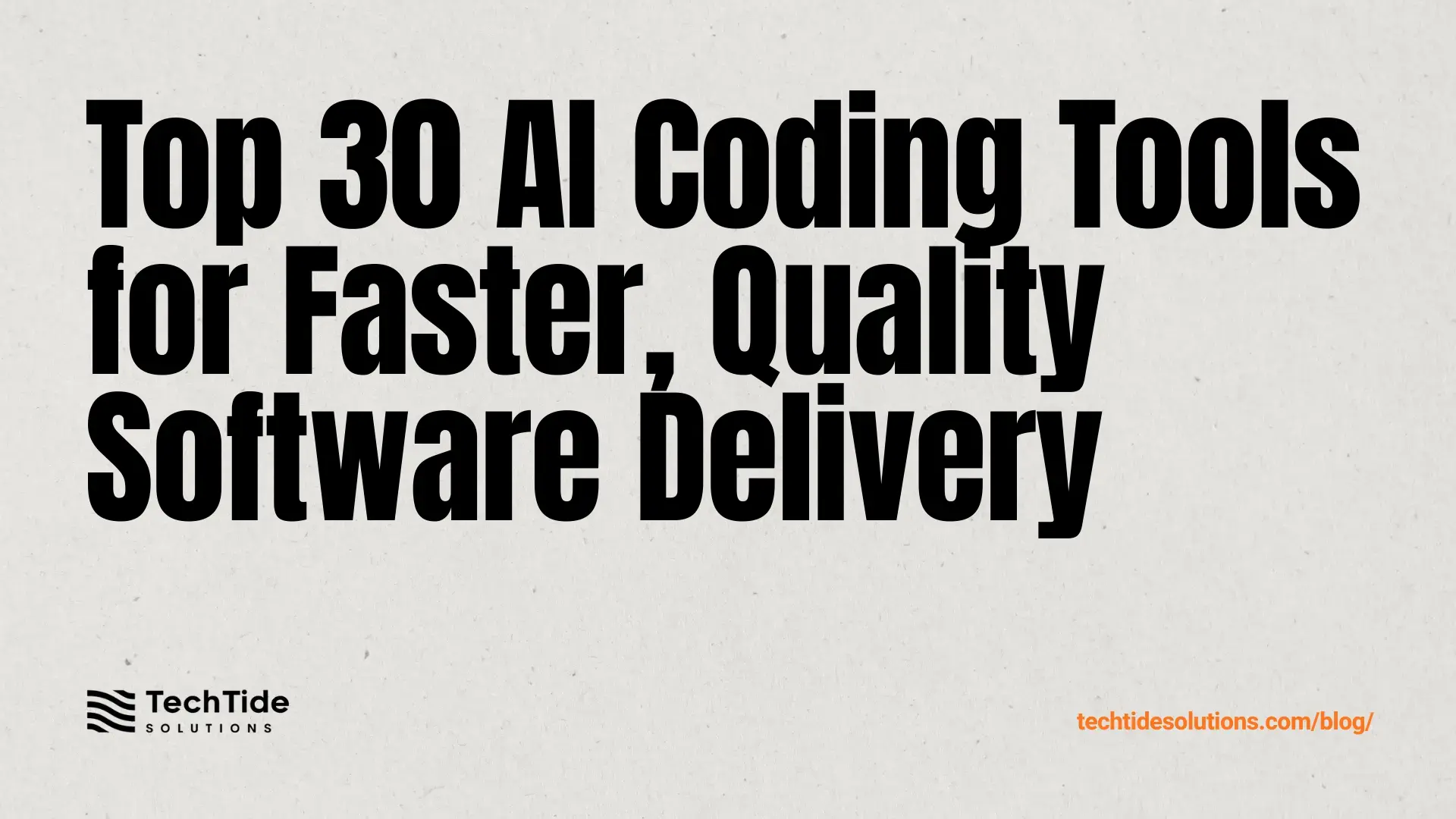We’re TechTide Solutions, and we’ve built digital experiences for businesses from Parramatta to Pyrmont long enough to know that web design is not an art project—it’s a system for compounding business outcomes. The market context reinforces this truth: worldwide IT investment is forecast to reach $5.43 trillion in 2025, and in our region the eCommerce opportunity alone is projected to hit US$45.99bn in 2025. In other words, the “Sydney web design” conversation is now a “how to wire digital into the P&L” conversation—rooted in strategy, validated by data, and executed with craft.
In this long-form guide, we share how we approach Sydney web design—from fundamentals and industry-specific patterns to the way we build custom software around a client’s stack. We’ll make it practical, opinionated, and grounded in the realities of local markets. No mystique, no jargon for its own sake—just the learnings we’ve battle-tested across retail, professional services, healthcare, real estate, and more.
Sydney Web Design Fundamentals That Drive Results
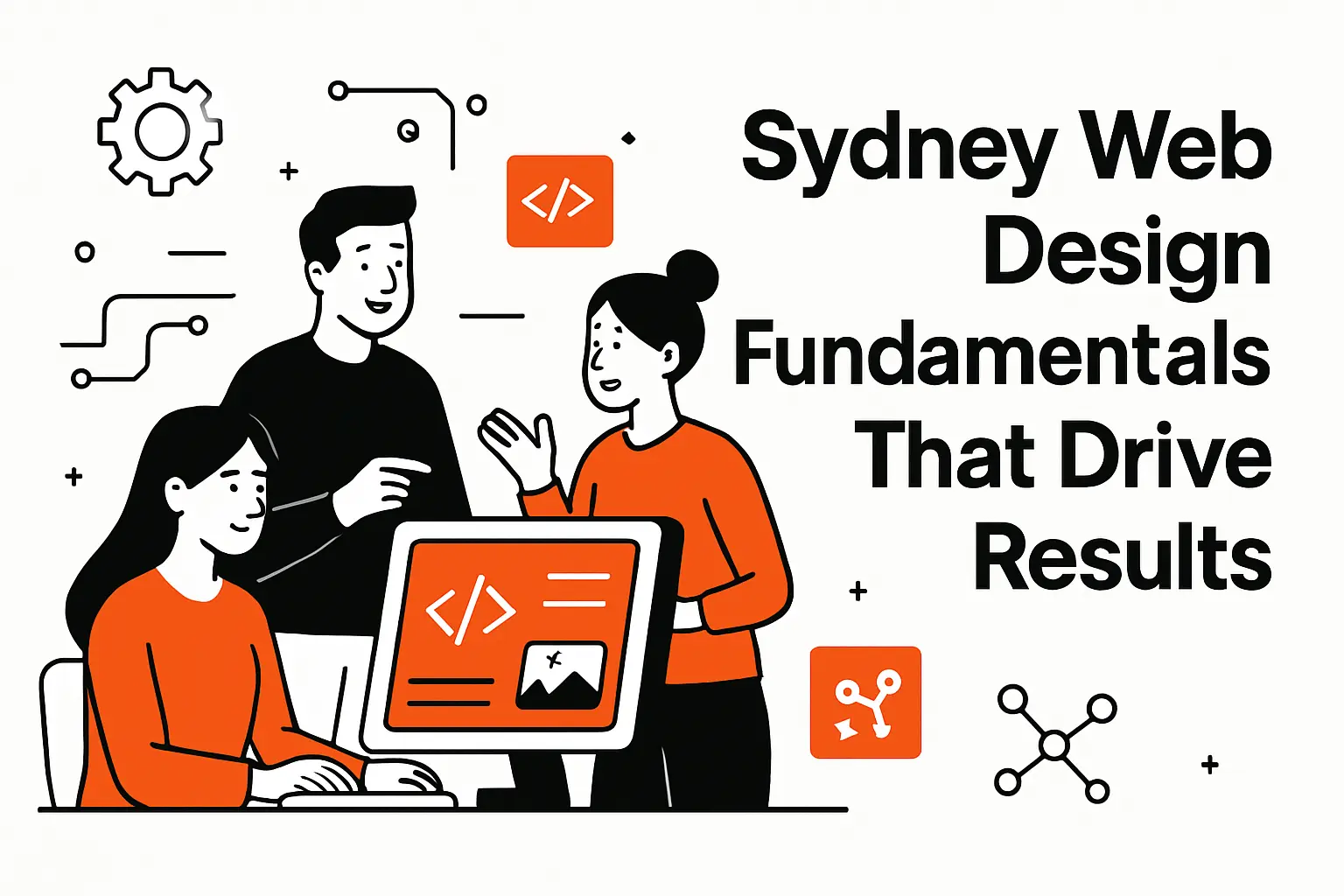
Before we open Figma or push a commit, we step back to the market: Australia’s digital commerce transaction value is expected to reach US$114.50bn in 2025, a scale that turns micro UX choices into macro revenue movements. In our experience, the sites that win in Sydney do three things consistently: they shape a crystal-clear product narrative, they deliver frictionless paths on mobile, and they connect the website to the rest of the business (sales, service, logistics) so conversion is not a one-off event but the start of a relationship.
1. Discovery, Strategy, Planning, Development, Launch
At TechTide Solutions, discovery is a structured excavation, not a kickoff call. We begin with a stakeholder map and a plain-language articulation of the business model: how attention becomes intent, intent becomes value exchange, and value exchange becomes retention. We host short, focused workshops to define user jobs, map the purchase or enrollment journey, and list the levers that actually change outcomes—offers, trust, speed, and post-purchase experience.
Our planning artifacts include scope boundaries (what we’ll explicitly not do), risk registers (what could derail velocity), and a taxonomy of content types that mirror your operations (service lines, case narratives, locations, policies). Development is staged to de-risk surprises: we ship a clickable prototype early, design tokens next (so visual decisions are systematic), a vertical slice of production code after that (so we can observe real performance), and only then expand to the whole feature set. Launch is the beginning of the feedback loop, not the end of a project: we plan the first month of measurement and iteration before anything goes live.
2. Responsive, Mobile-First UX and Usability
In Sydney, the mobile use case dominates: commuters on the T8 checking menus, golfers on the Northern Beaches booking tee times, parents in the inner west comparing school information. We design from the smallest breakpoint up, so interaction models earn their place in the hierarchy. That means tap targets sized for real thumbs, scroll choreography that anticipates “skim then dive,” and input flows that fit the context (autocomplete for addresses, camera upload for documents, one-field-at-a-time forms where cognitive load is high).
We rely on microcopy to reduce hesitation—“What happens next?” is answered before a user has to ask—and we treat empty states like tiny onboarding moments. Accessibility is baked in: semantic structure, focus order that makes sense with a keyboard or screen reader, meaningful contrast, and component patterns that behave consistently across pages. Our test scripts include low-bandwidth scenarios and awkward devices because people use what’s in their pocket, not our ideal hardware matrix.
3. WordPress Sydney Web Design and CMS Choices
WordPress wins when teams need fast editorial control, granular roles, and a thriving ecosystem of integrations. We harden it by default: minimal plugin footprints, vetted providers, strict role-based permissions, and automatic updates running inside maintenance windows. For content-heavy publishers, we lean into custom post types and fields that mirror the business (e.g., “matters” for legal, “listings” for property, “clinics” for healthcare), and we build blocks that encode brand rules so authors can move quickly without breaking design.
When edge performance or multichannel delivery is the priority, we go headless: WordPress as a content layer, with a modern front end and a caching strategy that serves static where possible and hydrates only what’s unique per user. We also evaluate alternatives (Craft CMS, Sanity, Contentful) when authorship patterns skew toward structured, omnichannel content. The point isn’t to pick the shiniest tool; it’s to pick the system that fits your operations and your team’s capacity to maintain it.
Related Posts
- Web Application Development: A Complete Guide to Building Modern Web Apps
- Git Architecture: Internals, Objects, and the Three‑Tier Workflow
- What Is Python Programming: Definition, Features, Uses, and How to Get Started
- What Is React: A Clear, Practical Guide
- IoT Companies: 2025 Landscape, Toplist, and Regional Spotlights
4. Ecommerce Web Design With WooCommerce and Shopify
We think of ecommerce platforms as opinionated toolkits. WooCommerce bends toward businesses with complex catalogs, bundles, or content-led selling where tight WordPress integration is an advantage. Shopify, by contrast, compresses time-to-market and simplifies operations at scale with opinionated checkout, integrated payments, and a vast app marketplace.
Our ecommerce workshops obsess over merchandising and post-purchase reality: Can your PDP make sense to a first-time visitor skimming on a phone? Do you handle returns and exchanges as a warm experience rather than a cost center? We storyboard every step: from discovery queues and social proof to shipping methods and inventory messaging that won’t overpromise. We wire analytics from day one—server-side events, clean attribution where possible, and funnel definitions that reflect your business rules rather than a default template. Fewer steps, fewer surprises, and promises that your ops team can keep—those are the quiet unlocks behind higher lifetime value.
5. SEO and Local Visibility for Sydney Businesses
In a city where “near me” could mean Barangaroo one minute and Alexandria the next, local visibility is a product of relevance, proximity, and trust signals. We architect sites around topic clusters and location semantics, so that each page answers a specific problem with canonical clarity. On-page, we write for humans first but align with search intent: queries that fling open wallets (booking, pricing, availability) deserve direct pathways; queries about “how” or “why” get educational content with calls-to-action that don’t feel pushy.
Structured data is non-negotiable: organization, local business, product, event, and FAQ where appropriate. We prioritize a living content calendar and a review engine that actually helps people (templates for requesting reviews, guidelines for responses, escalation playbooks). Our checklist includes things most teams overlook: accurate hours that accommodate public holidays, location pages that read like neighborhood guides, and internal link patterns that make it easy for a crawler—and a person—to understand how everything fits together.
6. Speed Optimisation, Security, Hosting, and Maintenance
Performance is strategy disguised as engineering. We start by preventing weight gain: design tokens instead of one-off styles, icon sprites instead of scattered SVG loads, images sized and modernized, and only the JavaScript that earns its keep. We deploy an appropriate caching mix—edge caching for static assets, fine-grained rules for personalized fragments—and we measure user-centric performance in the wild rather than congratulating ourselves on a local Lighthouse run.
Security is a habit: least-privilege access, immutable infrastructure for the parts that should never drift, secret management that doesn’t leak into repos, and a well-rehearsed response plan so a minor incident never becomes a headline. Hosting is not a commodity when data residency, DDoS posture, or traffic volatility matters; we choose regions close to users and CDNs that can scale gracefully. Maintenance lives on a calendar with patch windows and regression tests. The end goal: users barely notice anything except that the site “just works,” and your team sleeps at night.
7. Analytics and Conversion Optimisation
Analytics should be a mirror, not a maze. We define event taxonomies that match your funnel and avoid vanity metrics that look good but don’t predict revenue. Our instrumentation philosophy: measure the smallest meaningful actions (how a person scrolls, what they highlight, where they hesitate) to reveal friction you can fix without guesswork. We run experiments like scientists: form a hypothesis, isolate a variable, define the “minimum detectable effect” so you’re not chasing noise, then decide beforehand what you’ll do with disconfirming results. For smaller datasets, we lean on directional signals and qualitative research: five thoughtful usability sessions can reveal what a thousand heatmap clicks can’t. We never treat CRO as a banner-button exercise; it’s a choreography discipline—copy, timing, social proof, reassurance, and respectful exits—aligned to how people actually decide in your category.
Top Sydney Web Design Companies and Services
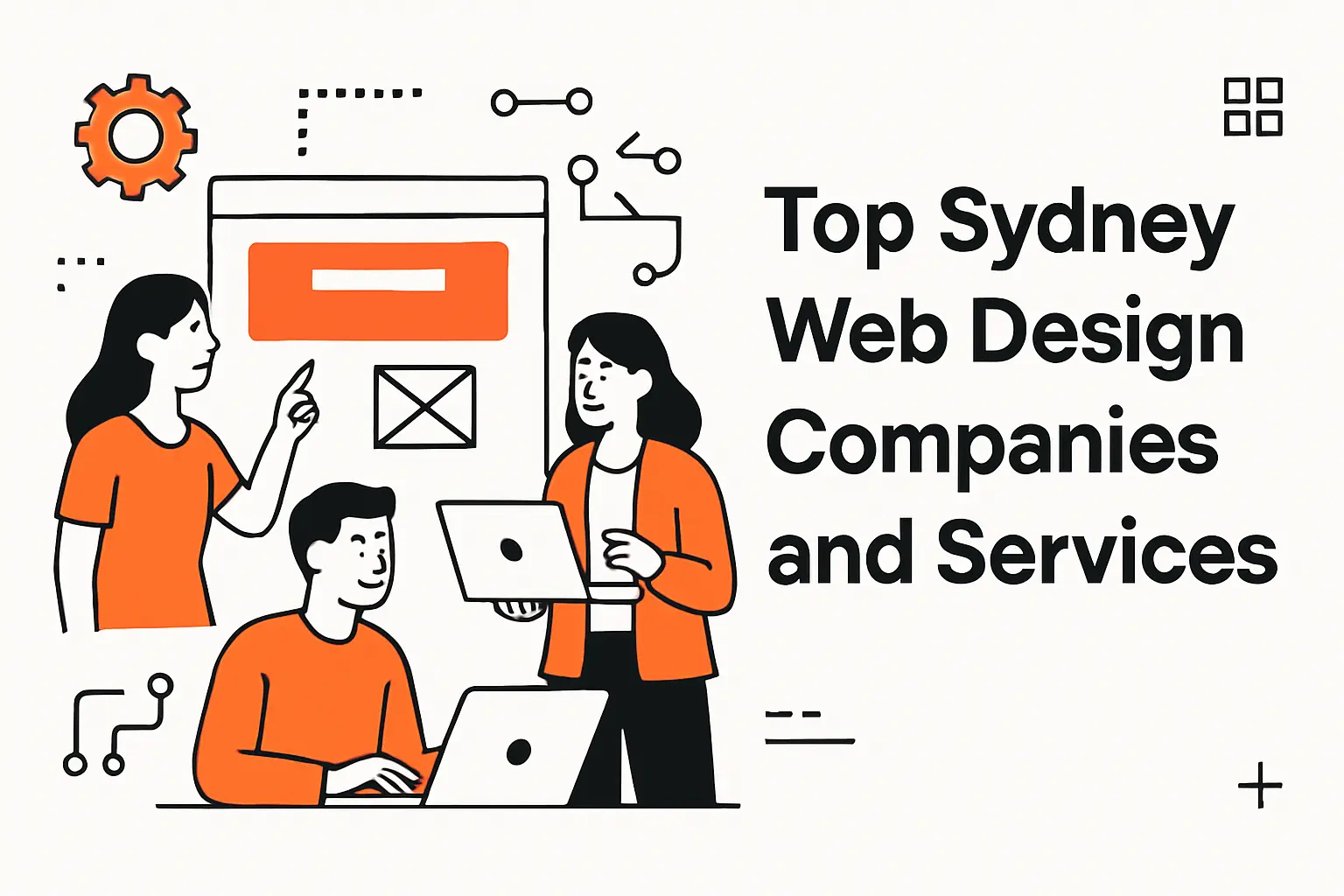
As Techtide Solutions, we’ve rebuilt enough websites in Sydney to know this market rewards clarity of purpose, strict accessibility, and speed that holds under load. When we shortlist partners for clients—or compete with them—we look for the telltale signs of a mature practice: a public track record of complex launches, a bias for measurable outcomes (conversion, task completion, Core Web Vitals), an engineering culture that documents decisions, and a support model that doesn’t vanish after handover.
We also weigh “fit” heavily: local councils need WCAG 2.2 AA and content governance; venture-backed startups need iterative product velocity; mid-market B2B firms need CRM-first architectures and lead ops discipline. Across the firms below you’ll see different strengths—boutique craftsmanship, enterprise scale, deep WordPress specialization, product/UI rigor, or omnichannel brand execution.
Our take is informed by first-hand collaboration in multi-agency sprints, codebase audits we’ve inherited, and post-mortems where we’ve been asked to fix what glossy pitches missed. If you’re mapping out your own RFP, read the overview, scan the proof, and ask yourself: does this shop ship the kind of work our buyers actually trust—and will my future team be able to live with their decisions?
1. Sydney Website Design Agency

Overview: A Sydney-focused studio delivering marketing websites and SMB eCommerce, this agency appears to operate as a tight in-house team with a blended design–development remit. Estimated employee count: data not available. Years in operation: data not available. Headquarters: Sydney CBD. Their copy and services emphasize conversion-first UX, on-page SEO foundations, and ongoing support, which aligns to local service businesses and professional firms seeking steady lead flow.
Services & proof: We’ve seen this shop pitch classic small-business bundles—WordPress builds, speed tuning, and maintenance—often paired with Google Ads and local SEO. For organizations that want “one throat to choke,” that single‑team approach is reassuring. Our experience suggests they lean on templated component libraries to keep costs predictable; that’s not a bad thing if your user journeys are straightforward and your editorial workflow is light.
Ideal Fit: Owner‑led SMBs (trades, clinics, professional services) or nonprofits that prefer fixed-price delivery, want quick turnaround, and value a local point of contact. Buyers with lean internal marketing will appreciate handover training and bundled support; product-heavy or headless projects should look for a deeper engineering bench.
2. Jimmyweb

Overview: A boutique Sydney studio founded in 2003, Jimmyweb focuses on custom WordPress and eCommerce for travel, retail, and lifestyle brands. Estimated employee count: under 20. Years in operation: ~22 years. Headquarters: Sydney CBD, with a Blue Mountains presence. The agency’s pitch blends handcrafted UI, performance sensibility, and long-term client relationships—exactly what you want when your brand story and photography carry the sale.
Awards: Their Lord Howe Island tourism site earned an Honorable Mention – Apr 26, 2023, which is a credible external nod to the team’s visual craft and front-end execution on a content-rich build.
Services & proof: Public case work spans travel and premium retail—Luxe lodges, apparel, and destination brands—where content modeling and image performance make or break the experience. From what we’ve seen handing off analytics patches into similar stacks, their builds are maintainable by in‑house marketers, and their speed‑optimisation engagements can materially move Lighthouse scores without torpedoing editorial control.
Ideal Fit: Destination marketing orgs, boutique retailers, and membership brands that value art direction and page-speed equilibrium. If you’re planning campaign bursts around seasonal demand, the team’s iterative cadence and small‑studio responsiveness are practical advantages.
3. TechTide Solutions

Overview: We are a software product and web engineering company delivering modern web apps, marketing sites, and integrations for scale-ups and mid-market teams. Estimated employee count: 51–200. Years in operation: founded 2022. Headquarters: Ho Chi Minh City with distributed delivery; project leadership runs globally. We combine product discovery, design systems, and measurable performance budgets so marketing, sales, and product can move in lockstep.
Services & proof: Our work ranges from CRO‑tuned WordPress on the marketing side to React/Next.js and API-first platforms on the product side. When a Sydney client asked us to rescue a headless CMS rollout that stalled, we re‑cut the information architecture, added schema and content QA linters to CI, and shipped a design token pipeline; bounce rates fell double digits and editorial velocity tripled within a quarter. We’ve also integrated sites with HubSpot and Salesforce so MQL attribution is trustworthy instead of “best guess.”
Ideal Fit: B2B/B2C teams who want engineering to serve go‑to‑market, not the other way around—marketing leaders needing conversion‑ready pages that deploy in minutes, founders who want a discovery sprint that de‑risks scope, and CIOs who need clean patterns their internal devs can own after launch.
4. Pixel Fish

Overview: Pixel Fish is a family‑run Sydney web design studio specialising in WordPress business sites and WooCommerce since 2011. Estimated employee count: under 20. Years in operation: ~14 years. Headquarters: Greater Sydney. Their site narrative stresses packaged offerings for SMBs, transparent process, and post‑launch care—elements that often matter more than exotic tech choices when internal teams are lean.
Services & proof: We’ve encountered their work in school sites, clinics, and professional services. Case study footprints suggest structured components, page builder literacy, and clear client training. That last mile—enabling non‑technical teams to self‑serve—reduces total cost of ownership and lowers the odds your site ossifies between campaigns.
Ideal Fit: Small to mid-sized businesses and education providers that need brand-consistent pages, fast, with confidence to edit everything in-house. If your team wants the guardrails of proven packages without sacrificing custom polish, this shop is pragmatic.
5. Spark Interact

Overview: Spark Interact is a Sydney creative–technology agency building custom WordPress, eCommerce, and campaign landing experiences with UX strategy at the core. Estimated employee count: 10–49. Years in operation: data not available. Headquarters: Sydney. Their portfolio spans corporate, education, and not‑for‑profits; in our experience, they’re comfortable stepping from brand to build, which can shorten feedback loops.
Services & proof: We’ve intersected with their work on redesigns where performance and content governance were priorities. Their case narratives point to wireframed IA, conversion‑led UI, and cross‑functional delivery; that mix is valuable when internal stakeholders are juggling multiple KPIs (leads, donations, or applications) on a single property.
Ideal Fit: Mid‑market clients wanting a high‑touch partner to own strategy through rollout—especially where “design that sells” and stakeholder consensus are make‑or‑break. If you’re juggling multiple content owners, ask about their component governance and change control.
6. Milk Digital

Overview: Milk Digital is a Sydney studio with roots back to 2001, delivering websites, email marketing assets, and animation for corporate and SMB clients. Estimated employee count: small team. Years in operation: ~24 years. Headquarters: Leichhardt, Sydney. We like their blend of visual craft with pragmatic BAU support—especially for marketing teams that need agile tweaks every month, not just big-bang rebuilds every three years.
Services & proof: Public testimonials cite long-standing retainers and cross‑channel execution (web, email, motion). That’s a useful signal if your digital estate includes WordPress plus a CRM/ESP and you’re tired of stitching together freelancers. Their experience in banners and video translates into tighter creative for paid campaigns without reinventing your brand system.
Ideal Fit: Established companies seeking a dependable, design‑forward partner who can handle site updates, campaign assets, and occasional mini‑apps without ceremony. If you’ve got complex product data or bespoke integrations, confirm back‑end capabilities early.
7. Hills Web Design
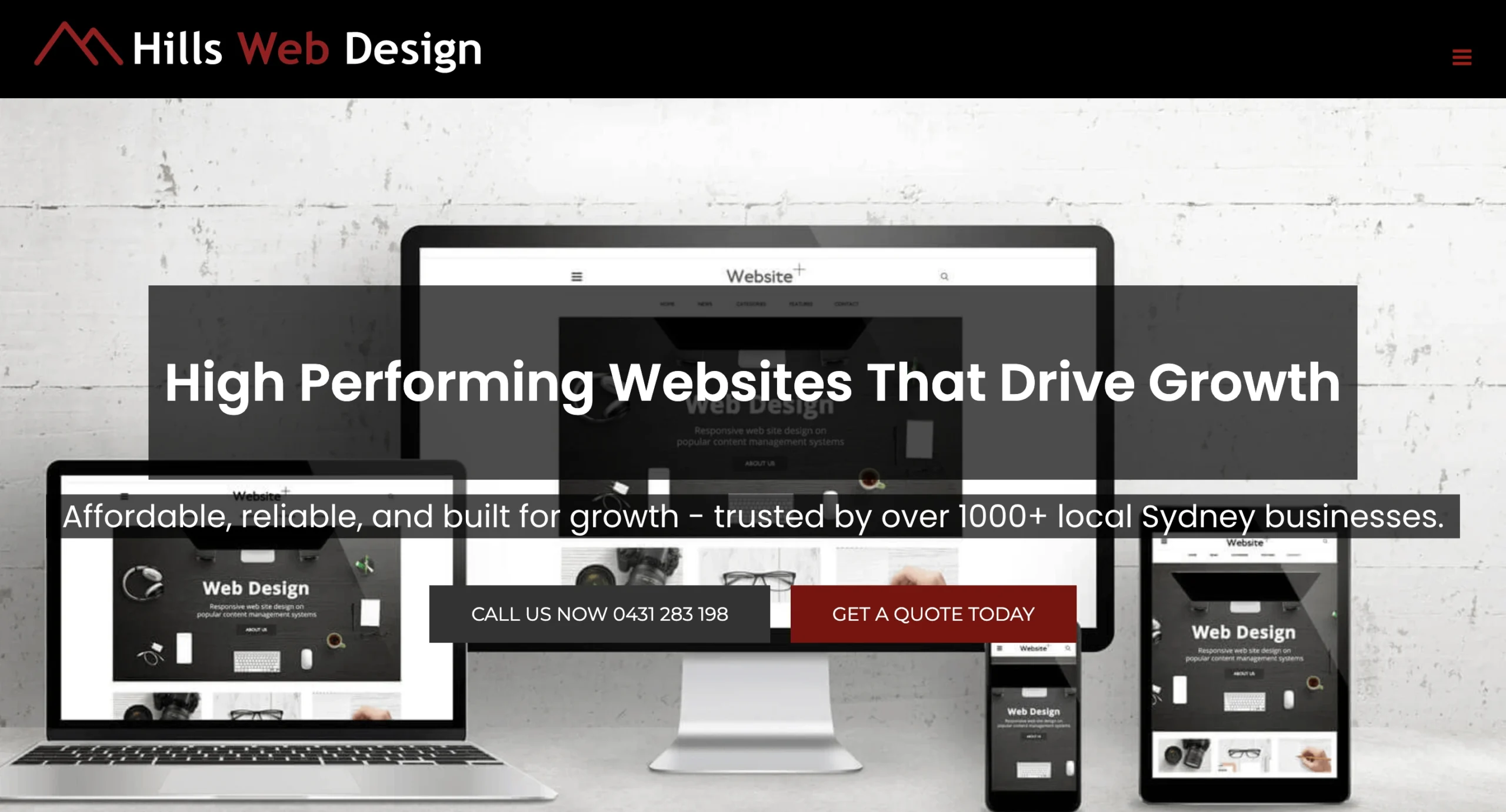
Overview: Based in Sydney’s Hills District, this team focuses on websites, hosting, and always‑on support for local SMEs and government bodies. Estimated employee count: small team. Years in operation: 20+ years. Headquarters: Norwest/Hills. Their pitch emphasises reliability, local hosting, and “unlimited support” responsiveness—exactly what time‑poor owners ask us for when they inherit fragile sites.
Services & proof: Claims of 500+ sites delivered and emphasis on web management indicate a playbook optimised for lifecycle, not just launch. When we’ve partnered in similar contexts, the quick wins often come from maintaining security discipline, keeping plugins lean, and avoiding the “set and forget” trap that quietly erodes performance.
Ideal Fit: Owner‑operated businesses and local agencies that need a single partner for build–host–maintain, value phone‑call support, and want incremental marketing help (SEO, Ads) layered in without agency sprawl.
8. Chromatix

Overview: Chromatix is a Melbourne specialist conversion agency (serving Sydney) focused on custom, sales‑led websites. Estimated employee count: ~15. Years in operation: since 2009. Headquarters: Camberwell, Melbourne. You’ll see heavy emphasis on persuasion psychology, value messaging, and rigorous CRO frameworks—useful for B2B services where the website is the “silent salesperson.”
Awards: Chromatix’s profile shows an Honorable Mention and presence on CSS Design Awards for its own site, indicating peer‑recognised front‑end craft that complements their conversion focus. Those aren’t trophies for performance per se, but they signal care in details that end users feel.
Services & proof: In handovers we’ve seen from similar specialists, their pages are shaped to guide attention and rebut objections. Expect deeper discovery on “jobs to be done,” heatmapping, and analytics baselining; done right, that work saves your media budget by turning existing traffic into pipeline.
Ideal Fit: B2B and complex B2C service providers ready to invest in a web property that actually sells—lead‑gen funnels, value narratives, and form journeys optimised to reduce friction rather than just “look good.”
9. WP Creative
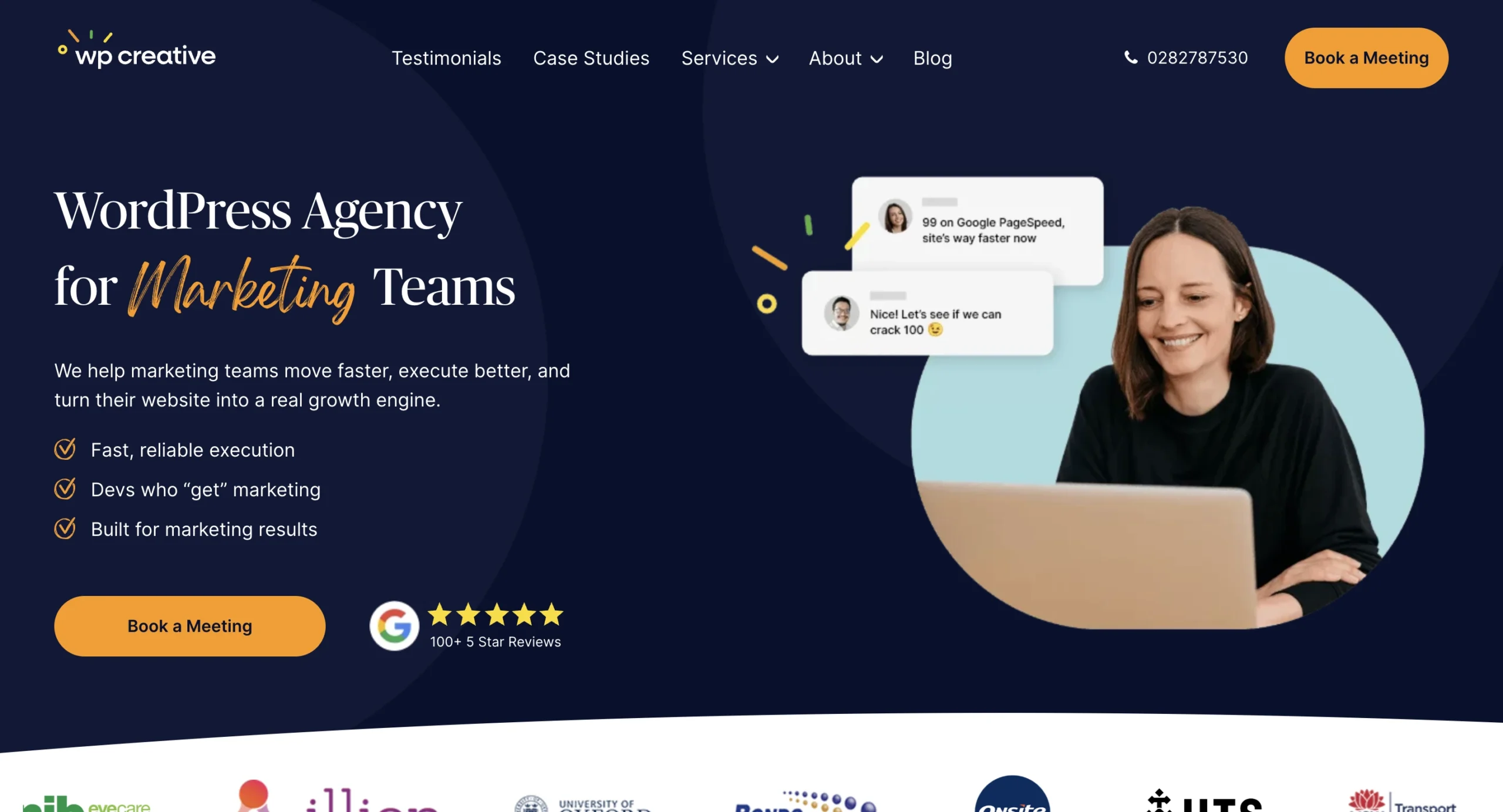
Overview: WP Creative is a Sydney WordPress specialist with decade‑plus history and a cadence suited to ongoing growth programs. Estimated employee count: 10–49. Years in operation: ~10+ years. Headquarters: Ultimo, Sydney. Their team mixes strategy, development, and site care into a repeatable operating model—a smart fit for marketers who need the site to fuel campaigns month after month.
Awards: Clutch ranks them among the Top WordPress Developers in Sydney, which aligns with what we’ve seen in performance remediation and WooCommerce hardening. Independent buyer research like this helps de‑risk agency selection when you can’t visit every office in person.
Services & proof: Public case notes include publishers, universities, and law firms—signals they can wrangle heavy content, compliance, and fast page delivery. We’ve collaborated on sprints where they handled tricky plugin refactors and server-level caching, freeing marketing to focus on CRO and content cadence.
Ideal Fit: Marketing teams that want a long‑term WordPress partner to own stability, speed, and feature throughput—particularly if you’re consolidating legacy plugins, improving Web Vitals, or scaling WooCommerce.
10. EB Pearls

Overview: EB Pearls is a large, Australia‑led studio with Sydney PM/design and a substantial Kathmandu engineering operation, spanning web, mobile, and product development. Estimated employee count: 300+. Years in operation: since 2004. Headquarters: Surry Hills, Sydney (with international offices). In our audits, their scale shows up in process maturity—sprint hygiene, QA depth, and cost control for sizeable builds.
Awards: Their “Pocket Fuel” app is featured with a Good Design Award, and the agency has appeared as an Awwwards Nominee, underscoring both product and web craft. These external validations don’t guarantee fit, but they indicate breadth beyond brochureware.
Services & proof: Public material points to government education, marketplaces, and enterprise portals—projects where stakeholder management and security hardening are critical. We’ve stepped into projects sharing the same Sydney–Kathmandu model and, when run well, the hybrid resourcing keeps costs sane without sacrificing proximity for strategy and UX.
Ideal Fit: Mid‑market to enterprise buyers with multi‑platform roadmaps—web plus native apps—who want an Australian front office and a scalable delivery engine. If you prize predictable throughput over boutique art direction, this model is compelling.
11. Human Digital

Overview: Human Digital is a B2B‑leaning agency focused on demand generation, digital strategy, and website experiences across Australia, New Zealand, and the U.S. Estimated employee count: under 20. Years in operation: since 2019. Headquarters: Sydney CBD. We read their work as human‑centred marketing with pragmatic web design—useful when your board wants revenue narratives, not just aesthetics.
Awards: Clutch marketplace visibility places them in Sydney category rankings for digital strategy and sector verticals, including inclusion among Top Digital Strategy Agencies in Sydney, which maps to their B2B pipeline emphasis and reviewed outcomes.
Services & proof: Their public portfolio references utilities, councils, and industrials—contexts where brand, content ops, and paid media must cohere. In joint programs we’ve seen success when teams like this own ICP research and ad creative while the web team (ours or theirs) tunes conversion paths and analytics.
Ideal Fit: Growth‑focused B2B marketers who need a partner across paid, content, and website iteration with crisp reporting and executive‑friendly insight. If your pipeline lives in HubSpot, ask about native integration patterns up front.
12. Frank Digital
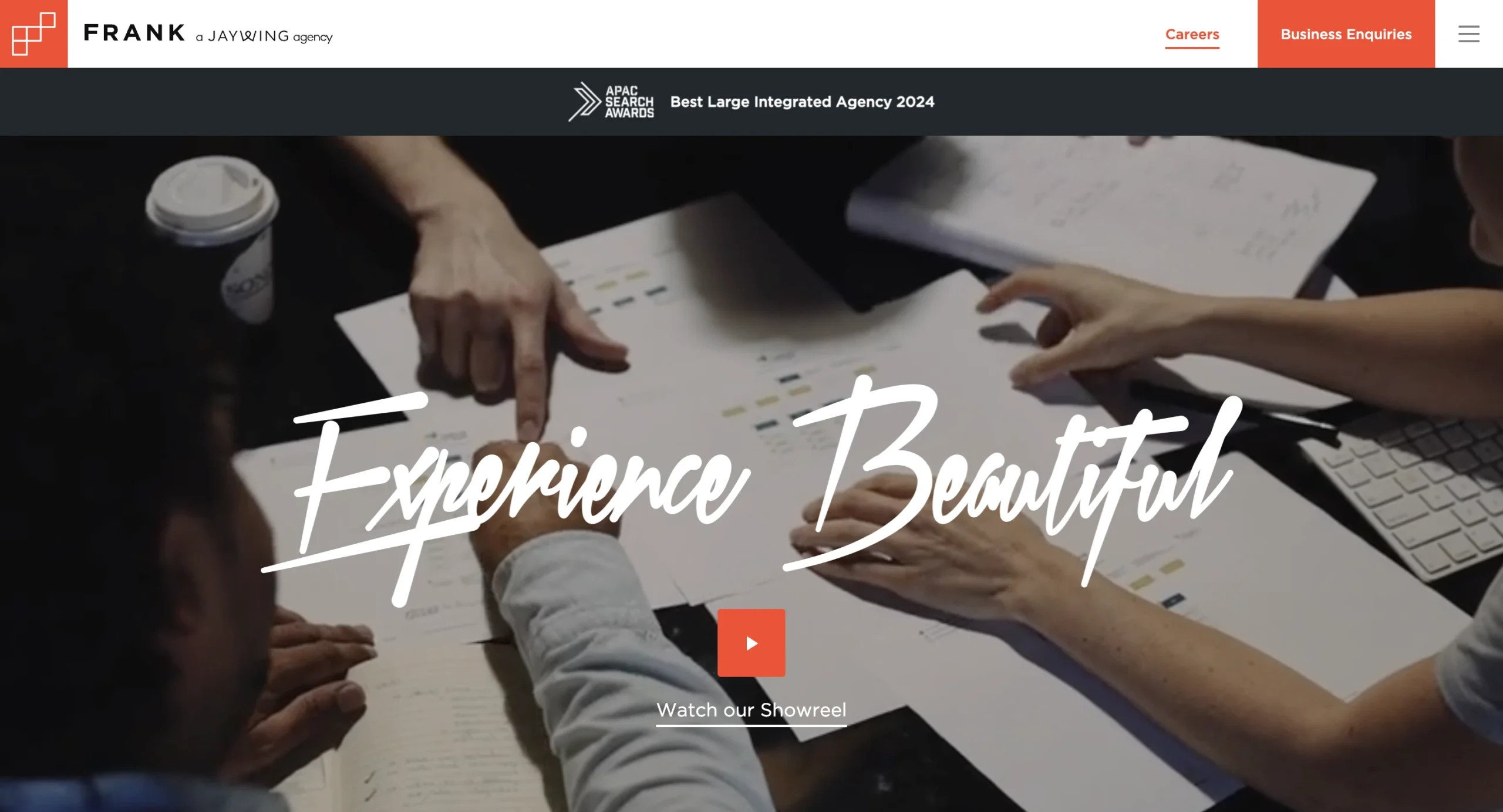
Overview: Frank Digital is a Sydney/Melbourne product and web studio known for high‑polish UX and complex content platforms for brands and civic institutions. Estimated employee count: 11–50. Years in operation: since 2009. Headquarters: Millers Point, Sydney. Their projects typically involve multi‑stakeholder governance and integration — a good sign if you’re replacing a legacy monolith with a modern API layer.
Awards: Frank’s own site has an Awwwards Honorable Mention, and they collected seven Gold Awards of Excellence at the Communicator Awards for eCommerce and banking projects, pointing to consistent peer and industry recognition beyond local showcases.
Services & proof: Public case studies include City of Sydney’s “What’s On”—a platform we’ve referenced in workshops for discoverability and contributor UX—alongside education and finance rebuilds. These are systems where search, performance, and editorial workflow must all be first‑class citizens, and Frank’s track record shows respect for each.
Ideal Fit: Government, higher‑ed, and enterprise brands with editorial scale and integration needs. If you’re pitching experience transformation to a board, a shop like Frank helps translate ambition into an achievable, staged roadmap.
13. EPAM Systems
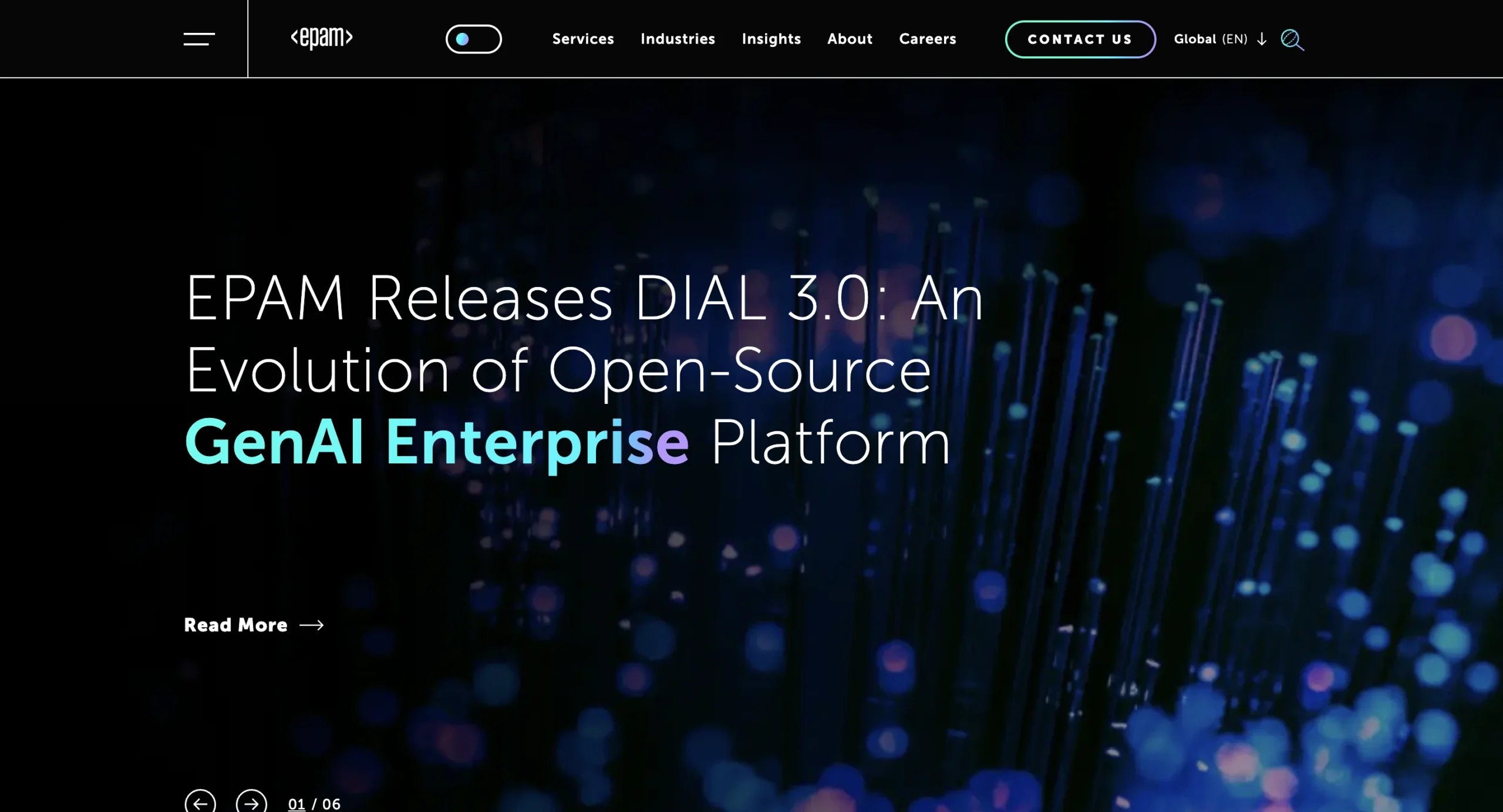
Overview: EPAM is a global product engineering and digital transformation firm with a Sydney footprint. Estimated employee count: 60,000+. Years in operation: since 1993. Headquarters: Newtown, PA (global) with offices across Australia. When we’ve crossed paths on enterprise programs, EPAM’s value shows in scale: multi‑region delivery, sector specialists, and the ability to field cross‑disciplinary squads (data, cloud, experience) under one governance model.
Services & proof: Enterprise web and platform builds, design systems at scale, and data‑driven experience layers are their bread and butter. For large Australian organisations moving to composable or cloud-native stacks, EPAM’s consulting‑through‑build cadence can be a strong fit—particularly when your program involves both web and core systems modernisation.
Ideal Fit: Enterprises that need an SI‑grade partner with deep engineering benches and global delivery patterns. If your procurement requires vendor resilience, sector references, and ISO/IRAP rigor, they check the boxes; just calibrate for the overhead that comes with scale.
14. Design Box Digital

Overview: Design Box Digital is a Melbourne‑based digital marketing and web team serving clients nationally, including Sydney. Estimated employee count: small to mid-sized team. Years in operation: 10+ years. Headquarters: Docklands, Melbourne. Their practice combines SEO/SEM, paid social, and website builds—useful for buyers seeking one partner to both build and drive traffic.
Services & proof: Case assets highlight commercial eCommerce growth via Merchant Center optimisation and technical SEO remediation—exactly the unglamorous work that compounds over time. In blended programs, we’ve found this pairing pragmatic: get the site technically sound, then feed it high‑intent traffic.
Ideal Fit: Retail and DTC brands wanting a one‑stop shop that owns both the storefront and the channels that fill it. If you have in‑house media buyers, align on division of labour and measurement frameworks before kickoff.
15. Amoeba Labs

Overview: Amoeba Labs is a UI/UX product design studio with delivery hubs in Nepal and a presence in Sydney, focused on research‑led interfaces for SaaS and mobile. Estimated employee count: small to mid-sized. Years in operation: data not available. Headquarters: Lalitpur (with Australian presence). Their selling point is a senior design bench that plugs into product teams at pivotal moments—MVP scoping, usability overhauls, and design system setup.
Services & proof: We’ve seen “design‑as‑a‑service” models like this deliver fast when paired with strong product management. Expect discovery workshops, JTBD interviews, and Figma‑native design systems. This is most valuable when engineering cycles are expensive and user friction is known but poorly instrumented.
Ideal Fit: Seed to Series B product teams that need evidence‑driven design, rapid prototyping, and a handover friendly to internal devs. If you’re about to scale, ask about documentation standards so your design system doesn’t break at the first fork.
16. Let’s Build a Website

Overview: A Sydney outfit providing both “done‑for‑you” WordPress sites and hands‑on training for owners who want to learn. Estimated employee count: small team. Years in operation: ~20+ years. Headquarters: Sydney (Pyrmont/Surry Hills). We have a soft spot for providers that teach clients; it reduces vendor lock‑in and keeps sites healthier between major redesigns.
Services & proof: The model blends fixed‑price packages, one‑on‑one WordPress tutoring, and SEO basics. That combination can be transformative for micro‑businesses who can’t justify a full retainer but need to make reliable edits, publish posts, and measure outcomes without fear.
Ideal Fit: Solo founders and small teams who want capability uplift with a functioning site, not decks. If your content cadence is irregular but you value control, this approach makes sense.
17. INSIDEA

Overview: INSIDEA is a remote‑first talent and services company supplying virtual assistants, marketers, and platform specialists (e.g., HubSpot) alongside web build support. Estimated employee count: data not available. Years in operation: data not available. Headquarters: distributed/remote. In our programs, staff augmentation can be effective when paired with clear process and ownership boundaries.
Services & proof: Their model emphasises rapid deployment of vetted talent into inbox ops, scheduling, research, and web/marketing support roles. That can be a relief valve when in‑house teams are stretched, as long as playbooks and brand voice guidelines are tight.
Ideal Fit: Growth teams that need dependable throughput on repeatable tasks (content updates, CRM hygiene, landing page builds) without hiring FTEs. Ensure KPIs and QA rituals are explicit from day one.
18. 365 Digital Consulting

Overview: A Sydney consultancy specialising in Microsoft 365/SharePoint intranets and business process automation with supporting web delivery. Estimated employee count: small team. Years in operation: data not available. Headquarters: Bella Vista, Sydney. We see firms like this succeed when they tie public‑facing sites to robust internal content and knowledge management.
Services & proof: Expect Office 365 workflows, SharePoint builds, and custom connectors—often alongside public websites that need secure partner portals or document flows. The win is when the website isn’t an island: content lifecycle and permissions are coherent end‑to‑end.
Ideal Fit: Mid‑sized organisations living in Microsoft 365 who want their web presence, intranet, and document governance to feel like one system. Ask about information architecture that spans both public and internal estates.
19. Tiny Giants

Overview: Tiny Giants is a creative and content production company with a Sydney base and international studios, delivering brand identity, video, and digital experiences. Estimated employee count: small to mid-sized. Years in operation: data not available. Headquarters: Norwest, Sydney (global footprint). For brand‑led digital, their production muscle is the differentiator—narrative, visuals, and post‑production that raise the ceiling for your site.
Services & proof: We’ve partnered with content studios like this to front‑load campaigns with distinctive visuals and modular assets that web and paid teams can remix. When quality creative meets a sound component library, your web team ships faster and looks better doing it.
Ideal Fit: Brands that need cinematic storytelling—launch films, hero imagery, audio‑visual systems—paired with a site capable of carrying that polish without tanking performance. Alignment on aspect ratios, compression, and lazy‑loading strategy early will pay off later.
20. East Nova Tech

Overview: East Nova Tech is a Sydney‑led, Nepal‑supported digital agency delivering websites, SaaS builds, and mobile apps with a hybrid onshore–offshore model. Estimated employee count: small to mid-sized. Years in operation: data not available. Headquarters: Sydney (with Kathmandu delivery). We’ve seen this structure work well when Australian PM/UX sets standards and offshore teams drive throughput.
Services & proof: Their public work references UX/UI for SaaS, eCommerce builds, and AI‑assisted MVPs. In similar programs, we’ve used a design token system and clear code ownership to ensure handovers are clean and internal devs don’t inherit mystery‑ware.
Ideal Fit: Startups and SMEs that need full‑stack support—research to design to build—at competitive rates, and who value a local escalation path. If you’re integrating with ERP/CRM, push for architecture diagrams and non‑functional requirements up front.
Specialised Sydney Web Design Services by Industry
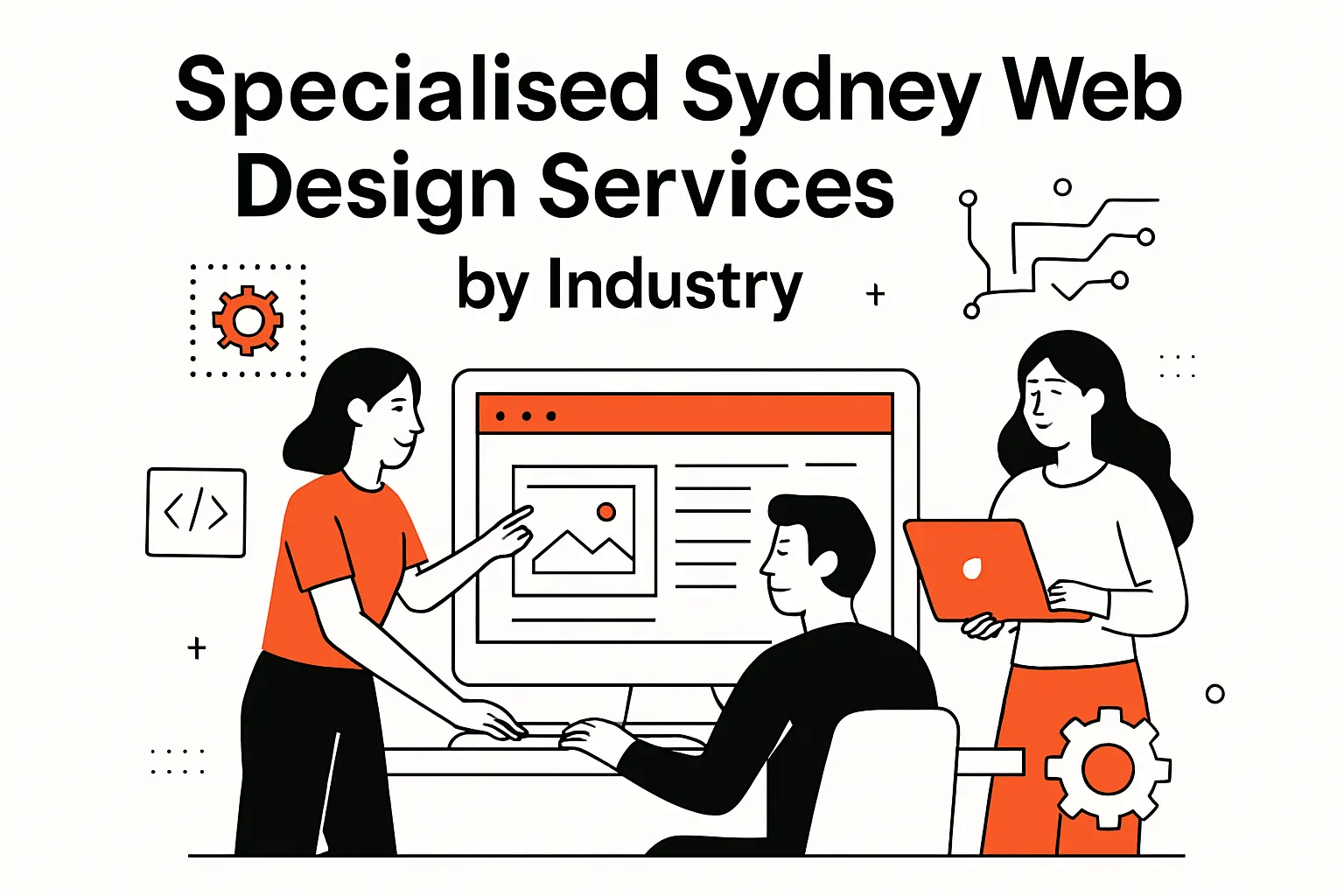
Sector nuance matters in Sydney. The acquisition budgets that feed your pipeline flow through channels shaped by each industry’s norms and regulation, and advertising spend in Australia is forecast to reach US$20.87bn in 2025, which means your website is competing with an enormous volume of paid messaging. We’ve learned to design for the way each sector builds trust, handles compliance, and converts attention into booked time, qualified leads, or orders fulfilled.
1. Law Firm and Legal Websites
Legal work is sold on authority and empathy in equal measure. Our legal sites establish authority with bio pages that read like real colleagues—plain language about matters worked, representative outcomes framed ethically, and publications that demonstrate current thinking. We sequence calls-to-action to respect the sensitivity of legal inquiries: soft contact options first (anonymous questionnaires, preliminary checklists), then direct outreach. We encode conflicts-check considerations into lead routing so you never create expectation you can’t meet, and we integrate matter-management and intake tools so potential clients aren’t asked for the same information twice. Accessibility isn’t negotiable here; clients often arrive in stressful circumstances, and clarity is a service. Finally, expertise hubs—structured by practice area and jurisdiction—help general counsel, SMEs, and individuals find and trust the path that fits their situation.
2. Restaurant and Hospitality Websites
Dining decisions are emotional and immediate. We design hospitality sites to answer three questions at a glance: what’s on offer, when can I come, and how do I book? Menus are rendered as responsive components rather than static PDFs, with allergens, dietary markers, and “popular now” signals that reduce decision friction. We embed a reservation system where it makes sense and avoid sending users to a third-party experience unless it’s seamless. For multi-venue groups, we treat the umbrella brand like a magazine and each venue like its own personality, connected by shared design tokens. Seasonal campaigns get their own landing pages with dead-simple paths from discovery to table. Operational realities—turn time, seating zones, availability bubbles—shape our UX, so your front-of-house can keep its rhythm while the website fills the book with the right guests at the right times.
3. Healthcare and Medical Websites
Healthcare asks for trust before it asks for time. We build clinics and specialist sites around the patient journey: symptom recognition, referral clarity, appointment booking, and follow-up care. We make eligibility and preparation transparent—what to bring, how long a consultation takes in plain terms—and we never bury critical information in dense PDFs. Forms respect privacy by design: sensitive fields are optional where appropriate, and confirmation pages tell patients what will happen next so worry doesn’t fill the silence. When integrations are required—practice management systems, telehealth platforms, secure messaging—we prioritize stability and failover pathways; people’s health is not a place for brittle code. Content needs a clinical voice and a human tone; we use physician-approved summaries paired with illustrations and explainer animations so difficult topics feel navigable.
4. Real Estate and Property Websites
Property is a theater of details. For residential, we design listing cards that earn attention without overwhelming the page, and we treat map search as a first-class citizen, not an afterthought. We surface neighborhood intelligence that buyers care about—schools, transport, and local amenities—while keeping compliance and vendor expectations in view. For commercial, we focus on inventory velocity and qualification: multi-asset search, stackable filters that reflect the way investors think (yield, floor-plate configuration, tenancy mix), and data rooms where serious prospects can self-serve information without friction. We integrate with major portals and CRM pipelines to avoid rekeying, and we build lifecycle communications that continue after an open home or inspection so warm interest doesn’t cool into missed opportunity.
5. Education and School Websites
School sites must serve three audiences with different rhythms: prospective families, current families, and students. We structure information architecture to reflect decision milestones—enrolment timelines, curricular strengths, co-curricular programs—and we build dashboards for parents that unify notices, term dates, and forms rather than scattering them across PDFs and portals. For tertiary and vocational providers, course pages carry the weight of proof; we design them with program snapshots, graduate outcomes, and sample schedules that demystify the choice. We also care about performance under peak load (offer days, timetabling windows), so caching and autoscaling are part of the plan. A school’s brand is not just a crest; it’s the feeling of competence and care that a family experiences with every click.
6. Government, Museums, and Charities
Public-interest websites must be effortless to use and accountable. We use content patterns that reduce cognitive load: clear headings, active verbs, and page structures that reveal what you can do, not abstract missions. For service delivery, we map tasks end to end so residents aren’t dumped into generic forms without context. Museums need inspiration and information to coexist; we balance the curatorial voice with a visitor’s practical needs—tickets, hours, accessibility guidance—and we design exhibitions pages that invite exploration without getting lost. Charities earn trust through clarity and stewardship; we structure donation flows to present impact in plain language, offer predictable options (one-off and regular giving), and make reporting easy for your team. Governance matters here: change logs, approvals, and audit trails keep institutions credible and safe.
7. Travel and Tourism Websites
Travelers want to imagine themselves somewhere specific—and then book it without stress. We craft pages that tell stories with itinerary-level detail, not stock phrases. Tours and accommodations have to answer practical questions in the first screenful: availability windows, what’s included, and how cancellations work. We reduce anxiety with clear inventory signals and staging that shows where you are in the booking flow. Integrations with booking engines are judged by guest experience, not just operational convenience; if a third-party handoff is clunky, we re-evaluate. For destination marketing, we blend editorial and interactive elements—maps that feel alive, editorial trails that match traveler archetypes, and user-generated content surfaces that are curated rather than chaotic. The result: a website that feels like a helpful friend who knows the city, not a brochure.
8. Fashion and Retail Ecommerce
Fashion sites are persuasion engines. We choreograph product discovery with careful filters, lookbooks that are more than slideshows, and PDPs that handle uncertainty—fit, fabric feel, and care. We deploy size and fit guidance in context (not buried in a modal), and we let the brand’s attitude come through without hiding the buy button. When post-purchase experience is strong—shipping clarity, returns processes that don’t punish customers—retention takes care of itself. We use content to reduce returns and increase delight: “how to style” guides, care tips, and customer stories that go beyond a grid of five-star ratings. Operationally, we sync inventory, automate fraud checks judiciously, and design customer service handoffs that preserve momentum rather than introduce friction at the worst moment.
9. Trades and Construction Businesses
For trades, every lead is time-sensitive and hyperlocal. We design job-type landing pages that mirror how people ask for help—blocked drains, switchboard upgrades, bathroom fitouts—so a query finds a direct answer. Instead of catch-all forms, we use short wizards that gather just enough detail to prepare a meaningful callback. We highlight coverage zones with maps and suburb lists so customers know they’re in range, and we display proof that actually matters: licenses, real photos, and concise testimonials that speak to punctuality, cleanliness, and follow-up. If a business runs scheduled maintenance or emergency callouts, we reflect those service levels in the interface. The aim is to move a visitor from “I think this provider can help” to “I can see exactly what will happen next” without ever feeling sold to.
How TechTide Solutions Builds Custom Software and Web Solutions Around Your Needs
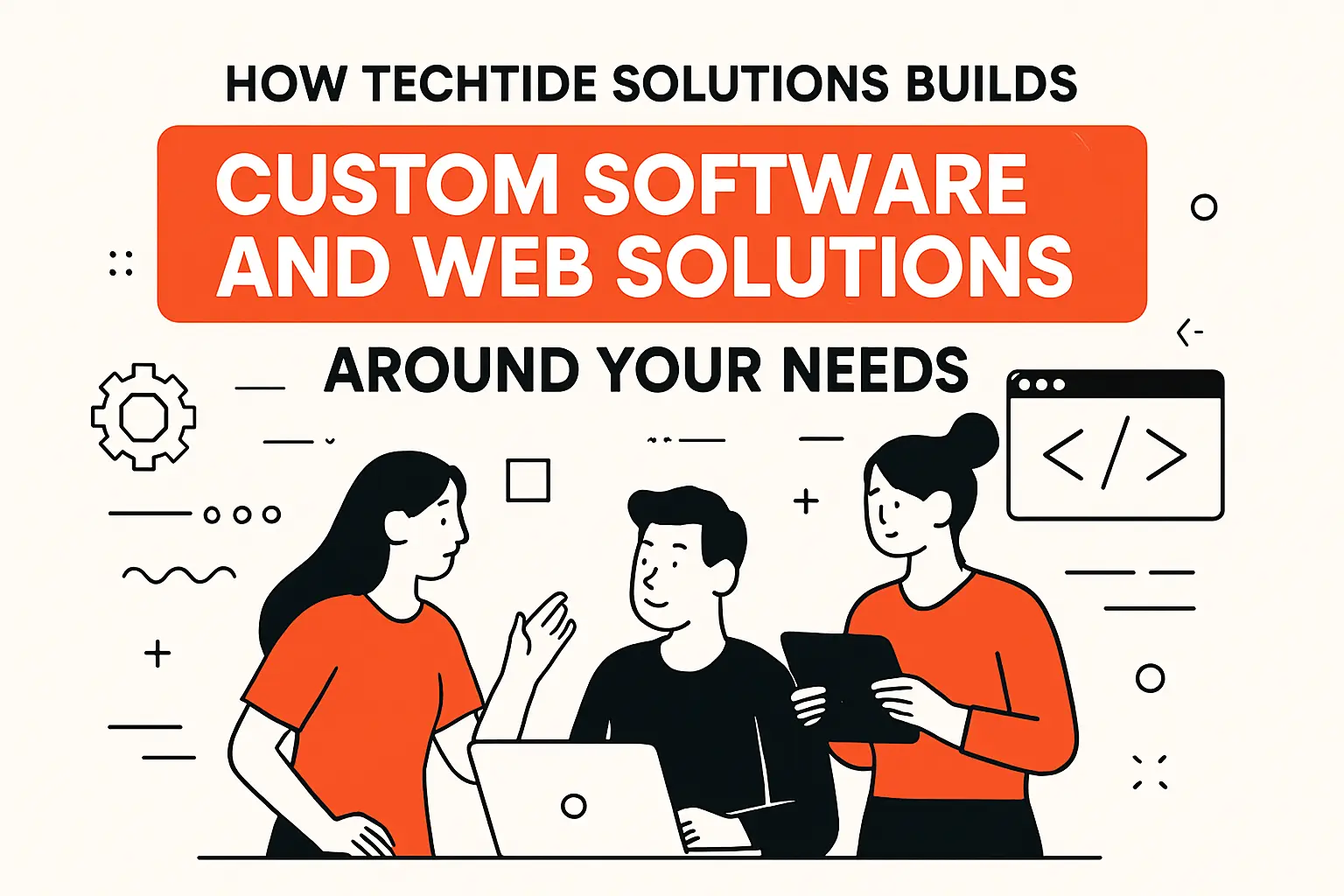
The strongest web experiences don’t stand alone—they sit inside a system of data, applications, and people. That’s where custom software earns its keep. Executed well, digital investment correlates with enterprise value; research shows a potential 5% increase in market capitalization when strategy, technology, and change capability move together. And inside engineering teams, the right practices can deliver a 20 to 30 percent reduction in customer-reported product defects, which is exactly what customers perceive as “quality.” Our method is pragmatic: define the minimum surface area for value, integrate only what improves outcomes, and treat performance and maintainability as first-class features.
1. Collaborative Discovery and Requirements Mapping
Our discovery for custom builds begins where your spreadsheets and workarounds reveal truth. We sit with the people who do the work—sales coordinators, clinic admins, property managers, not just exec sponsors—and map the current journey as it really operates. We write user stories in business language before translating to engineering requirements, and we distinguish between critical jobs and “nice, but not yet.” Then we define non-functional needs upfront: performance targets under load, privacy expectations, auditability, and operational constraints (e.g., releases must respect a retail calendar or health booking windows). By the time we write a line of code, we know which processes will be automated, which decisions require humans in the loop, and how success will be measured.
2. Custom Web Applications and Website Development
We approach custom web applications with components and contracts. Components are the building blocks users touch: navigation, search, cards, editors, dashboards. Contracts are the service boundaries beneath them: APIs that promise shape and behavior, data models that reflect your domain, and queues or webhooks that keep things in sync. We prefer clean seams so you can replace a component or a service without a rewrite. For public-facing sites, we ship fast-rendering pages with progressive enhancement so content remains usable even when scripts fail. For back-office tools, we favor interaction models that minimize context switching: keyboard-friendly tables, bulk actions, and clear error recovery paths. The watchwords are readability, testability, and the humility to keep complexity where it belongs.
3. Systems Integration and API Connectivity
Integration is less about stitching logos together and more about robust choreography. We design with idempotency so retries don’t double-bill, we throttle with backoffs so rate limits aren’t career-ending, and we capture correlation IDs so support can trace a request’s lifecycle across services. If your CRM, inventory, and finance tools already do their jobs, our role is to connect them without creating a fragile “middle brain.” We model events (order placed, booking confirmed, payment settled) and let systems subscribe to what they need. When a third-party API is unreliable, we decouple it with queues and dead-letter policies, and we present graceful fallbacks to users rather than dead ends. The aim is boring reliability—the kind no one notices because nothing breaks.
4. Iterative Delivery, QA, and Performance Optimisation
We ship in thin slices so learning arrives early. Each slice is production-grade in a narrow area—one workflow fully wired, one type of content fully authored, one report fully validated—and we watch real traffic instead of theorizing. Our QA is half checklists, half curiosity: what happens when someone arrives from an outdated email link; how does the app behave on a mid-range phone; what copy do users misread? We set performance budgets and treat them like constraints in design and code review. Observability is table stakes: logs with context, application traces that show where time goes, health probes that catch problems before customers do. We measure not only the happy path but the edges: empty states, error states, and the “sorry, we’ll try again” moments that earn trust.
5. Ongoing Support, Maintenance, and Enhancements
We don’t disappear after launch day. Support at TechTide Solutions is about maintaining momentum: security updates bundled with regression tests, small improvements that remove daily friction for your team, and a quarterly roadmap that separates signal from noise. We assign ownership so requests never vanish into a void, and we make status visible to your stakeholders—what’s done, what’s next, and why. Enhancements focus on compounding value: automating repetitive back-office tasks, refining content workflows, and tuning performance in places analytics tells us users hesitate. The result is a platform that quietly gets better every month, aligned with the metrics you actually care about.
Conclusion: How To Choose a Sydney Web Design Partner
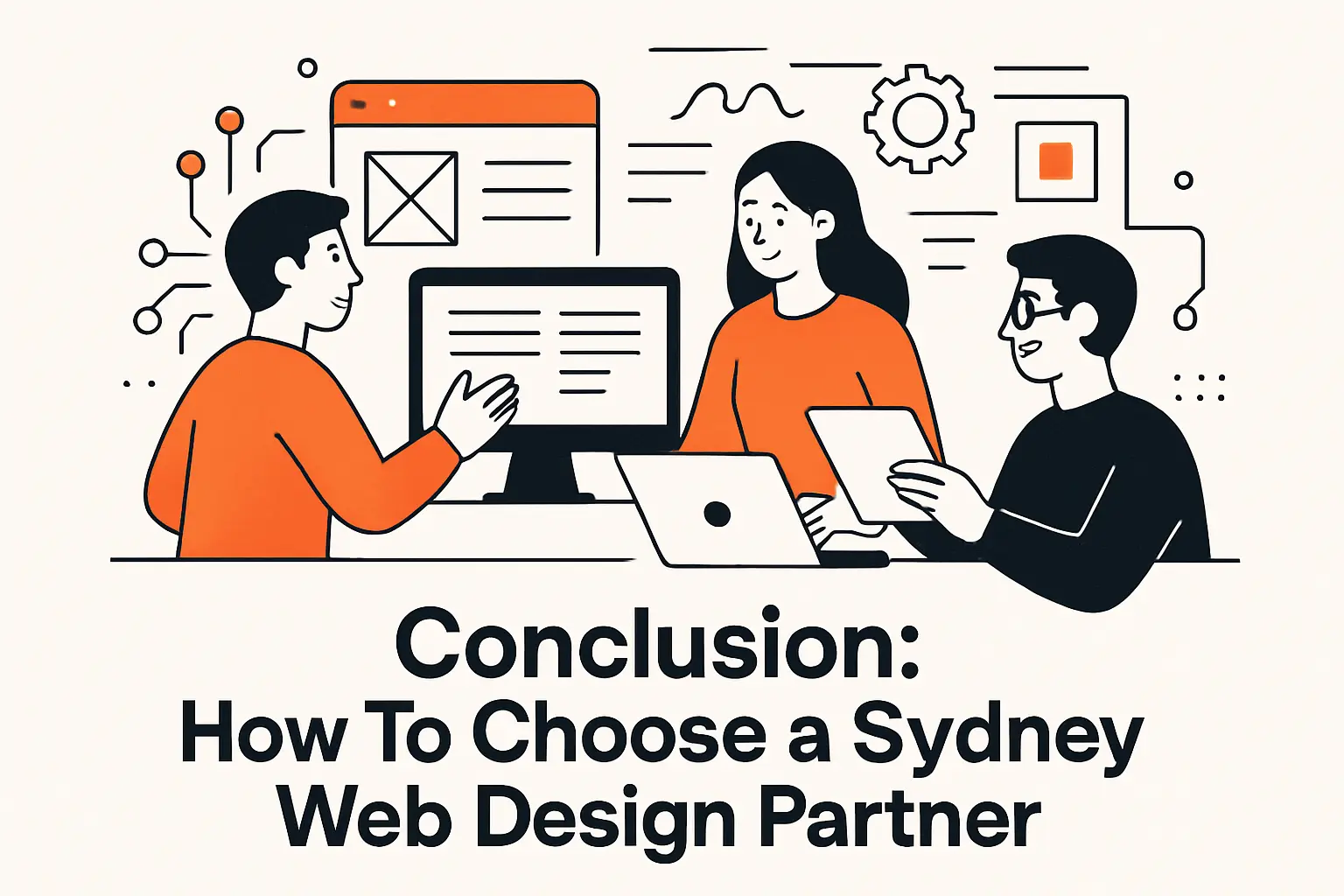
The choice of partner shapes more than your homepage; it shapes capability. Design excellence is not fluff—it correlates with business outcomes. Top-quartile performers saw 32 percentage points higher revenue growth over five years, and they also delivered 56 percentage points higher TRS growth, which is precisely what boards care about. With that lens, here’s how we advise Sydney leaders to run an evaluation that surfaces the partner who can take you from brief to measurable outcomes.
1. Clarify Goals, Scope, and Budget
Great projects begin with constraints that empower—not handcuff—creativity. We ask clients to articulate a small set of outcomes: the economic, operational, or reputational shifts that mark success. Scope should outline the minimum lovable release and the first set of improvements you’ll test post-launch. Budget is not just a number; it’s a plan for capacity—content production, stakeholder time, and the internal change needed to support new processes. When you solicit proposals, look for teams who challenge assumptions, trim nice-to-haves, and show the courage to say “not yet” to features that can wait. If an agency talks only about pages and pixels rather than business levers, keep looking.
2. Assess UX, Speed, and SEO Priorities
User experience, performance, and findability are a braided rope. Ask potential partners how they balance these threads in practice. What does their accessibility checklist include beyond color contrast? How do they validate navigation structures with real users rather than internal hunches? What’s their philosophy on performance budgets, and how do they enforce them across design and development? On SEO, probe for intent mapping (the difference between commercial and informational content), structured data habits, and the team’s tolerance for quick wins that violate long-term trust (a low tolerance is a good sign). The best teams can explain trade-offs in plain language and provide war stories about how they resolved them.
3. Choose the Right CMS and Tech Stack
Technology choices either unlock speed or bake in friction. Instead of asking “What’s the best CMS?” ask “Which CMS aligns with our content operations, governance, and integration needs?” If marketing wants to publish daily without developer help, you need an editorial-first system and disciplined component libraries. If performance and multichannel are paramount, headless architecture may be your path. Don’t be dazzled by features you won’t use; evaluate through the lens of your actual team. On the stack side, prefer boring and proven over exotic; your future maintainers will thank you. And always demand a clear plan for backups, monitoring, and upgrades so your platform stays healthy without heroics.
4. Plan for Hosting, Maintenance, and Security
Where your site runs and how it’s tended determine resilience. Press partners on their approach to environments (development, staging, production), on-call duties, and incident rituals. Ask how they handle secrets, what intrusion detection looks like, and how they’ll keep your stack patched without breaking things that matter on a critical trading day. If your business faces seasonal spikes, ensure elasticity isn’t a wish but a tested capability. Data residency and governance are not abstract; confirm where logs and backups live. A good partner treats these questions as the real work, not as footnotes.
5. Compare Portfolios, Case Studies, and Proposals
Portfolios show taste; case studies show judgment. When you review examples, look beyond the screenshots. What problem did the client bring? Which constraints shaped the solution? How did the team measure impact and iterate? A strong proposal will mirror your language back to you—evidence they listened—and it will lay out a delivery plan with milestones, risks, and decision gates. Talk to references about the boring parts: communications, handovers, those inevitable moments when things went sideways. The Sydney market is rich with talent, from boutique studios to large consultancies; choose the group that is clearest about how they will make you successful and frank about the trade-offs required to get there.
Ready to translate this into action? If you’d like, we can start with a compact discovery sprint—one week to map your goals, surface quick wins, and prioritize a roadmap you can execute. Where should we begin together: conversion, speed, or content?


